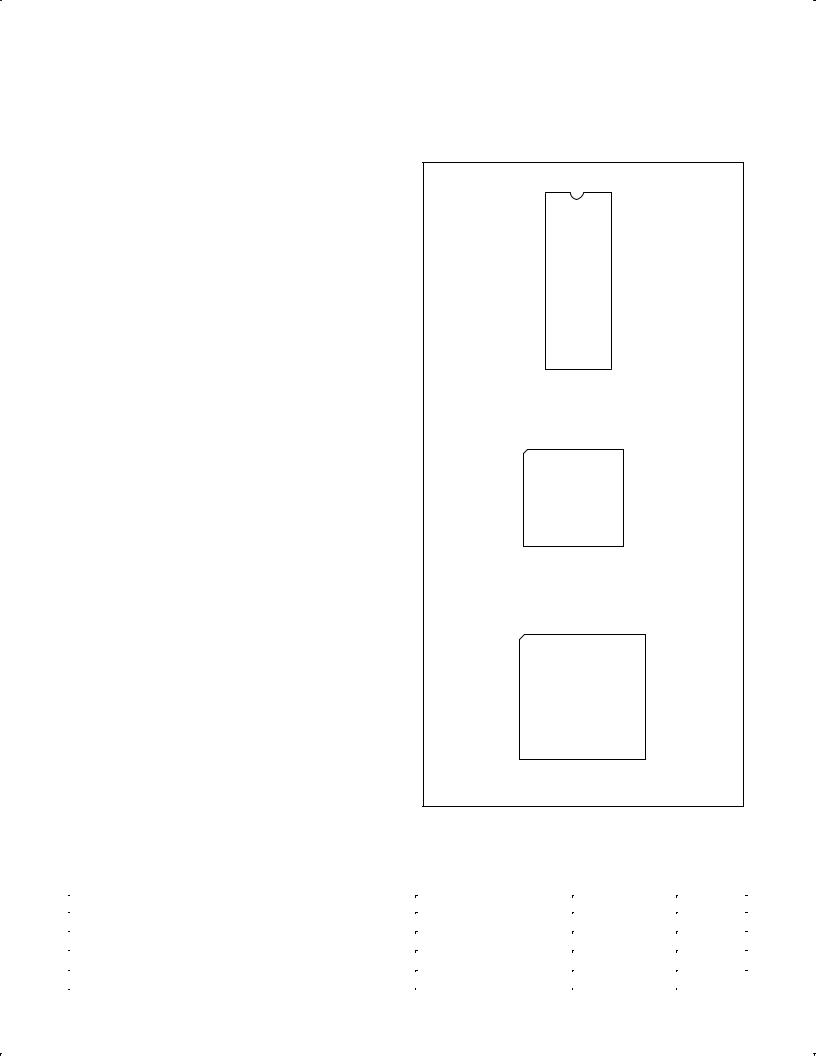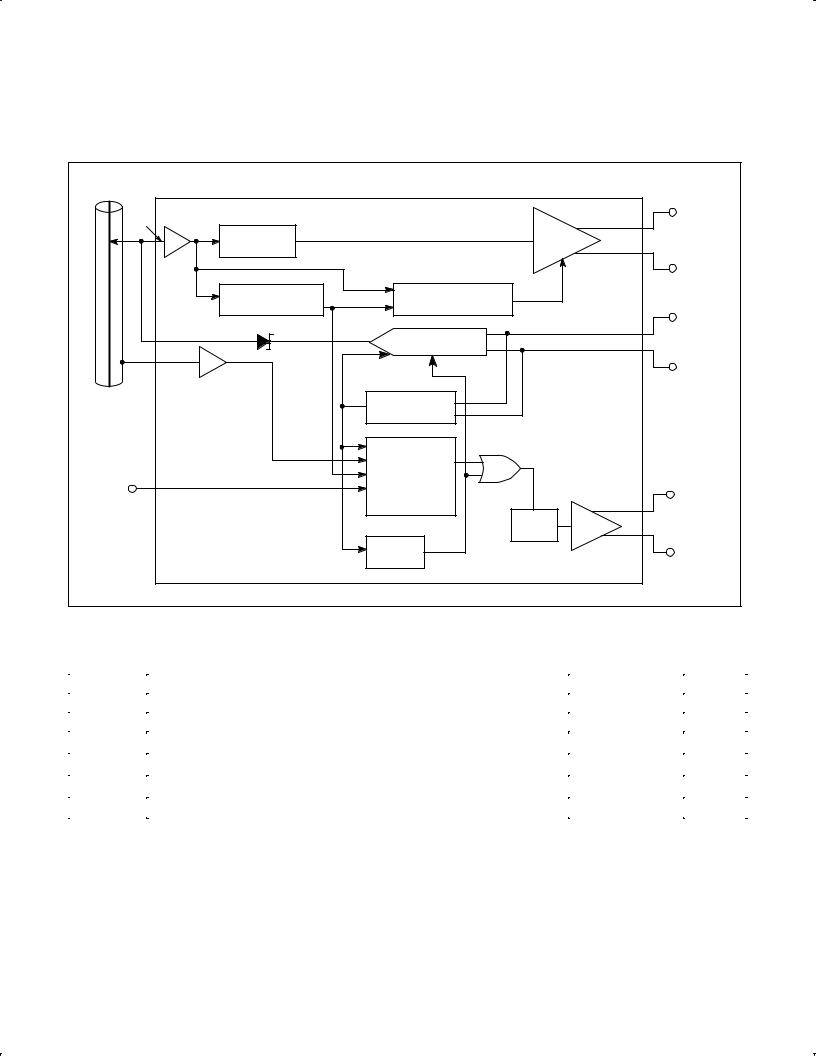Philips NE83Q92A20, NE83Q92N, NE83Q92A, NE83Q92D Datasheet

INTEGRATED CIRCUITS
NE83Q92
Low-power coaxial Ethernet transceiver
Product specification |
1995 May 01 |
IC19 Data Handbook
P s
on o s

Philips Semiconductors |
Product specification |
|
|
|
|
|
|
|
Low-power coaxial Ethernet transceiver |
NE83Q92 |
|
|
|
|
|
|
|
DESCRIPTION |
PIN CONFIGURATION |
The NE83Q92 is a low power BiCMOS coaxial transceiver interface
(CTI) for Ethernet (10base5) and Thin Ethernet (10base2) local area networks. The CTI is connected between the coaxial cable and the Data Terminal Equipment (DTE) and consists of a receiver, transmitter, receive-mode collision detector, heartbeat generator and jabber timer (see Block Diagram). The transmitter output connects directly to a doubly terminated 50Ω cable, while the receiver output, collision detector output and transmitter input are connected to the
DTE through isolation transformers. Isolation between the CTI and the DTE is an IEEE 802.3 requirement that can be met on signal lines by using a set of pulse transformers. Power isolation for the CTI is achieved using DC-to-DC conversion through a power transformer (see Figure 3, Connection Diagram).
The part is fully pin compatible with the industry standard 8392, but has substantially lower current consumption, is fully compliant with the IEEE802.3 standard, and has additional features such as optional pull-down resistors (Figure 3, Note 4), and automatic selection between AUI and coaxial connections.
The NE83Q92 is manufactured on an advanced BiCMOS process and is available with PLCC and SOL packages which make it ideally suited to lap-top personal computers or systems where low power consumption, limited board space and jumperless design is required. Refer to selection flow chart for optimal apllication.
FEATURES
•Fully compliant with Ethernet II, IEEE 802.3 10BASE-5 and 10BASE-2, and ISO 8802/3 interface specifications
•100% drop-in compatible with industry standard 8392 sockets (N & A options)
•Optimal implementation can use 1 Watt DC-DC converter and reduces external part count by not requiring external pull-down resistors
•High efficiency AUI drivers automatically power-down under idle conditions to minimize current consumption
•Automatically disables AUI drivers when no coaxial cable is connected, allowing hard-wiring of AUI connection and local/integrated CTI connection
•Smart squelch on data inputs eliminates false activations
•Advanced BiCMOS process for extremely low power operation
•Available in 16-pin DIP, 16-pin SOL and both 20and 28-pin
PLCC packages
•Expanded version (NE83Q93) with 5 LED status drivers is available for repeater and advanced system applications
•Full ESD protection
•Power-on reset prevents glitches on coaxial cable
D, N Packages
CD+ |
1 |
|
16 |
CDS |
|
|
|
|
|
|
|
|
|
|
CD± |
2 |
|
15 |
TXO |
|
|
|
|
|
|
|
|
|
|
RX+ |
3 |
|
14 |
RXI |
VEE |
|
|
|
VEE |
|
|
|
||
4 |
|
13 |
||
VEE |
|
|
|
|
5 |
|
12 |
RR± |
|
|
|
|
|
|
RX± |
6 |
|
11 |
RR+ |
|
|
|
|
|
|
|
|
|
|
TX+ |
7 |
|
10 |
GND |
|
|
|
|
|
|
|
|
|
|
TX± |
8 |
|
9 |
HBE |
A Packages
|
|
|
CD± |
CD+ |
N/C |
CDS |
TXO |
|
||||||
|
|
|
|
|
|
|
|
|
|
|
|
|
||
|
|
3 |
|
2 |
|
1 |
|
20 |
|
19 |
|
|
|
|
|
|
|
|
|
|
|
|
|
|
|
|
|
|
|
|
|
|
|
|
|
|
|
|
|
|
|
|
|
|
RX+ |
4 |
|
|
|
|
|
|
|
|
|
|
|
18 |
RXI |
|
|
|
|
|
|
|
|
|
|
|
|
|
|
|
VEE |
5 |
|
|
|
|
|
|
|
|
|
|
17 |
VEE |
|
|
|
|
|
|
|
|
|
|
|
|
|
|
||
|
|
|
|
|
|
|
|
|
|
|
|
|
||
V |
6 |
|
|
|
|
|
|
|
|
|
|
16 |
VEE |
|
EE |
|
|
|
|
|
|
|
|
|
|
|
|
|
|
|
|
|
|
|
|
|
|
|
|
|
|
|
||
|
|
|
|
|
|
|
|
|
|
|
|
|
||
VEE |
7 |
|
|
|
|
|
|
|
|
|
|
|
15 |
RR± |
|
|
|
|
|
|
|
|
|
|
|||||
|
|
|
|
|
|
|
|
|
|
|
|
|
|
|
RX± |
8 |
|
|
|
|
|
|
|
|
|
|
|
14 |
RR+ |
|
|
|
|
|
|
|
|
|
|
|
|
|
|
|
|
|
|
|
|
|
|
|
|
|
|
|
|
|
|
|
|
9 |
|
10 |
|
11 |
|
12 |
|
13 |
|
|
|
|
|
|
|
|
|
|
|
|
|
|
|
|
|
|
|
|
|
|
TX+ |
TX± |
GND |
HBE |
GND |
|
||||||
|
|
|
RX+ |
CD± |
CD+ |
CDS |
TXO |
N/C |
RXI |
|
||||||||
|
|
|
|
|
|
|
|
|
|
|
|
|
|
|
|
|
|
|
|
|
4 |
|
3 |
|
2 |
|
1 |
|
28 |
|
27 |
|
26 |
|
|
|
|
V |
|
|
|
|
|
|
|
|
|
|
|
|
|
|
|
|
|
|
|
|
|
|
|
|
|
|
|
|
|
|
|
|
|
|
|
|
|
5 |
|
|
|
|
|
|
|
|
|
|
|
|
|
|
25 |
|
||
EE |
|
|
|
|
|
|
|
|
|
|
|
|
|
|
|
|
|
VEE |
|
|
|
|
|
|
|
|
|
|
|
|
|
|
|
|
|
||
VEE |
6 |
|
|
|
|
|
|
|
|
|
|
|
|
|
|
24 |
V |
|
VEE |
|
|
|
|
|
|
|
|
|
|
|
|
|
|
|
|
|
EE |
7 |
|
|
|
|
|
|
|
|
|
|
|
|
|
|
|
23 |
V |
|
VEE |
|
|
|
|
|
|
|
|
|
|
|
|
|
|
|
|
|
EE |
8 |
|
|
|
|
|
|
|
|
|
|
|
|
|
|
22 |
V |
||
VEE |
|
|
|
|
|
|
|
|
|
|
|
|
|
|
|
|
|
EE |
9 |
|
|
|
|
|
|
|
|
|
|
|
|
|
|
21 |
V |
||
VEE |
|
|
|
|
|
|
|
|
|
|
|
|
|
|
|
|
|
EE |
10 |
|
|
|
|
|
|
|
|
|
|
|
|
|
|
20 |
V |
||
VEE |
|
|
|
|
|
|
|
|
|
|
|
|
|
|
|
|
|
EE |
|
|
|
|
|
|
|
|
|
|
|
|
|
|
|
|
|
||
11 |
|
|
|
|
|
|
|
|
|
|
|
|
|
|
|
19 |
RR± |
|
|
|
|
|
|
|
|
|
|
|
|
|
|
|
|
|
|
|
|
|
|
12 |
|
13 |
|
14 |
|
15 |
|
16 |
|
17 |
|
18 |
|
|
|
|
|
|
|
|
|
|
|
|
|
|
|
|
|
|
|
|
|
|
|
|
|
|
RX± |
TX+ |
TX± |
HBE |
GND |
GND |
RR+ |
|
||||||||
|
|
|
|
|
|
|
|
|
|
|
|
|
|
|
|
SD00302 |
||
Figure 1. Pin Configurations
ORDERING INFORMATION
DESCRIPTION |
TEMPERATURE RANGE |
ORDER CODE |
DWG # |
|
|
|
|
16-Pin Plastic Dual In-Line Package (DIP) |
0 to +70°C |
NE83Q92N |
SOT38-4 |
|
|
|
|
16-Pin Plastic Small Outline Large (SOL) Package |
0 to +70°C |
NE83Q92D |
SOT162-1 |
|
|
|
|
20-Pin Plastic Leaded Chip Carrier (PLCC) Package |
0 to +70°C |
NE83Q92A20 |
SOT380-1 |
|
|
|
|
28-Pin Plastic Leaded Chip Carrier (PLCC) Package |
0 to +70°C |
NE83Q92A |
SOT261-3 |
1995 May 01 |
2 |
853-1737 15180 |

Philips Semiconductors |
Product specification |
|
|
|
|
Low-power coaxial Ethernet transceiver |
NE83Q92 |
|
|
|
|
PIN DESCRIPTIONS
PIN NO. |
PIN NO. |
PIN NO. |
SYMBOL |
DESCRIPTION |
|
N PKG |
PLCC-20 |
PLCC-28 |
|
|
|
|
|
|
|
|
|
1 |
2 |
2 |
CD+ |
Collision Outputs. Balanced differential line driver outputs which send a 10MHz signal to the |
|
DTE in the event of a collision, jabber interrupt or heartbeat test. External pull-down resistors |
|||||
2 |
3 |
3 |
CD± |
||
are optional. |
|||||
|
|
|
|
||
|
|
|
|
|
|
3 |
4 |
4 |
RX+ |
Receiver Outputs. Balanced differential line driver outputs which send the received signal to |
|
6 |
8 |
12 |
RX± |
the DTE. External pull-down resistors are optional. |
|
|
|
|
|
|
|
7 |
9 |
13 |
TX+ |
Transmitter Inputs. Balanced differential line receiver inputs which accept the transmission |
|
8 |
10 |
14 |
TX± |
signal from the DTE and apply it to the coaxial cable at TXO, if it meets Tx squelch threshold. |
|
|
|
|
|
|
|
9 |
12 |
15 |
HBE |
Heartbeat Enable. The heartbeat function is disabled when this pin is connected to VEE and |
|
|
|
|
|
enabled when connected to GND or left floating. |
|
|
|
|
|
|
|
11 |
14 |
18 |
RR+ |
External Resistor. A 1kΩ (1%) resistor connected between these pins establishes the |
|
12 |
15 |
19 |
RR± |
signaling current at TXO. |
|
|
|
|
|
|
|
|
|
|
|
Receiver Input. This pin is connected directly to the coaxial cable. Received signals are |
|
14 |
18 |
26 |
RXI |
equalized, amplified, and sent to the DTE through the RX± pins, if it meets Rx squelch |
|
|
|
|
|
threshold. |
|
|
|
|
|
|
|
15 |
19 |
28 |
TXO |
Transmitter Output. This pin is connected directly (Thin Ethernet) or through an external |
|
isolating diode (Ethernet) to the coaxial cable. |
|||||
|
|
|
|
||
|
|
|
|
|
|
16 |
20 |
1 |
CDS |
Collision Detect Sense. Ground sense connection for the collision detection circuitry. This |
|
pin should be connected directly to the coaxial cable shield for standard Ethernet operation. |
|||||
|
|
|
|
||
|
|
|
|
|
|
10 |
11 |
16 |
GND |
Positive Supply Pin. |
|
13 |
17 |
||||
|
|
|
|||
|
|
|
|
|
|
4 |
5 ± 7 |
5 to 11 |
|
|
|
5 |
|
Negative supply pins. |
|||
16 ± 17 |
20 to 25 |
VEE |
|||
13 |
|
||||
|
1 |
|
N/C |
Not used. |
|
|
|
|
|
|
NOTE:
1. The IEEE 802.3 name for CD is CI; for RX is DI; for TX is DO.
1995 May 01 |
3 |

Philips Semiconductors |
Product specification |
|
|
|
|
Low-power coaxial Ethernet transceiver |
NE83Q92 |
|
|
|
|
BLOCK DIAGRAM
COAX |
|
|
|
DTE |
|
|
|
INTERFACE |
|
CABLE |
|
|
|
|
|
|
|
|
|
RXI |
BUFFER |
|
LINE |
|
|
RECEIVER |
|
DRIVER |
RECEIVE |
|
|
|
PAIR |
|
|
EQUALIZER |
|
|
|
|
|
|
(RX+, RX±) |
|
|
|
|
|
|
|
4±POLE BESSEL |
|
RECEIVER |
|
|
LOW PASS FILTER |
|
AC±DC SQUELCH |
|
|
TXO |
|
|
TRANSMIT |
|
TRANSMITTER |
PAIR |
||
|
|
|||
|
|
(TX+, TX±) |
||
|
CDS |
|
|
|
|
|
|
|
|
|
SENSE |
|
|
|
|
BUFFER |
|
|
|
|
|
TRANSMITTER |
|
|
|
|
SQUELCH |
|
|
|
|
COLLISION |
|
|
|
|
COMPARATOR |
|
|
|
HEARTBEAT ENABLE |
& |
|
|
|
HEARTBEAT |
|
||
|
|
|
||
|
|
GENERATOR |
|
|
|
|
|
10MHz |
COLLISION |
|
|
|
PAIR |
|
|
|
|
OSC |
|
|
|
|
(CD+, CD±) |
|
|
|
|
|
|
|
|
JABBER |
|
LINE |
|
|
TIMER |
|
DRIVER |
|
|
|
|
SD00274 |
Figure 2. Block Diagram
ABSOLUTE MAXIMUM RATINGS
SYMBOL |
PARAMETER |
RATING |
UNIT |
|
|
|
|
V |
Supply voltage1 |
±12 |
V |
EE |
|
|
|
V |
Voltage at any input1 |
0 to ±12 |
V |
IN |
|
|
|
TSTG |
Storage temperature range |
±65 to +150 |
°C |
TSOLD |
Lead soldering temperature (10sec.) |
+300 |
°C |
T |
Recommended max junction temperature2 |
+150 |
°C |
J |
|
|
|
θJA |
Thermal impedance (N and A packages) |
60 |
°C/W |
NOTE:
1.100% measured in production.
2.The junction temperature is calculated from the following expression:
TJ = TA + θJA [(VEE x 0.015 x nIDL) + (VEE x 0.027 x nRX) + (VEE x 0.075 x nTX)] where
TA |
= |
Ambient temperature in °C. |
θJA |
= |
Thermal resistance of package. |
VEE = |
Normal operating supply voltage in volts. |
|
nIDL = |
Percentage of duty cycle idle |
|
nRX = |
Percentage of duty cycle receiving |
|
nTX |
= |
Percentage of duty cycle transmitting |
1995 May 01 |
4 |

Philips Semiconductors |
Product specification |
|
|
|
|
Low-power coaxial Ethernet transceiver |
NE83Q92 |
|
|
|
|
ELECTRICAL CHARACTERISTICS
V = ±9V ±6%; T = 0°C to +70°C unless otherwise specified1,2. No external isolation |
|
|
|
|
||
EE |
A |
|
|
|
|
|
|
|
|
|
LIMITS |
|
|
|
|
|
|
|
|
|
SYMBOL |
PARAMETER |
TEST CONDITIONS |
MIN |
TYP |
MAX |
UNIT |
|
|
|
|
|
|
|
VUVL |
Under voltage lockout. Transceiver disabled for |
|
|
±7.5 |
|
V |
|VEE| < |VUVL| |
|
|
|
|||
|
|
|
|
|
|
|
|
Supply current idle |
|
|
±15 |
±20 |
mA |
IEE |
|
|
|
|
|
|
Supply current transmitting (without collision) |
Without external |
|
±80 |
±90 |
mA |
|
|
pull-down resistors |
|
||||
|
|
|
|
|
|
|
|
|
|
|
|
|
|
IRXI |
Receive input bias current |
VRXI = 0V |
±2 |
|
+25 |
μA |
ICDS |
Cable sense input bias current |
VCDS = 0V |
|
+1 |
+3 |
μA |
VIH |
HBE input HIGH voltage |
|
VEE +2.4 |
|
|
V |
VIL |
HBE input LOW voltage |
|
|
|
VEE +1.6 |
V |
IIH |
HBE input HIGH current |
VHBE = 0V |
|
|
+10 |
μA |
IIL |
HBE input LOW current |
VHBE = VEE |
±30 |
|
|
μA |
I |
Transmit output DC current level3 |
|
±37 |
|
±45 |
mA |
TDC |
|
|
|
|
|
|
I |
Transmit output AC current level3 |
|
±28 |
|
±I |
mA |
TAC |
|
|
|
|
TDC |
|
ITX10 |
Transmit current |
VTXO = ±10V |
±250 |
|
+250 |
μA |
V |
Transmitter output voltage compliance4 |
|
|
|
±3.7 |
V |
TCOM |
|
|
|
|
|
|
|
Collision threshold5 |
Measured by applying |
|
|
|
|
VCD |
DC voltage at RXI |
±1450 |
±1530 |
±1580 |
mV |
|
|
|
(CDS = 0V) |
|
|
|
|
|
|
|
|
|
|
|
VDIS |
AUI disable voltage at RXI |
Measured as DC |
|
±3.5 |
|
V |
voltage at RXI |
|
|
||||
VOD |
Differential output voltage ± non idle at RX± and |
|
±600 |
|
±1100 |
mV |
6 |
|
|
||||
|
CD± |
|
|
|
|
|
VOB |
Differential output voltage imbalance ± idle at |
|
|
|
±40 |
mV |
7 |
|
|
|
|||
|
RX± and CD± |
|
|
|
|
|
VOC |
Output common mode voltage at RX± and CD± |
RXI = 0V |
±4.0 |
±5.5 |
±7.0 |
V |
VRS |
Receiver squelch threshold |
VRXI average DC |
±150 |
±250 |
±350 |
mV |
(CDS = 0V) |
||||||
VTS |
Transmitter squelch threshold |
(VTX+ ± VTX±) peak |
±175 |
±225 |
±275 |
mV |
RRXI |
Shunt resistance at RXI non±transmitting |
|
100 |
|
|
kΩ |
CRXI |
Input capacitance at RXI8 |
|
|
1 |
2 |
pF |
RTXO |
Shunt resistance at TXO transmitting |
|
7.5 |
10 |
|
kΩ |
RAUIZ |
Differential impedance at RX± and CD± with no |
|
|
6 |
|
kΩ |
coaxial cable connected |
|
|
|
|||
RTX |
Differential impedance at TX± |
|
|
20 |
|
kΩ |
NOTES:
1.Currents flowing into device pins are positive. All voltages are referenced to ground unless otherwise specified. For ease of interpretation, the parameter limit that appears in the MAX column is the largest value of the parameter, irrespective of sign. Similarly, the value in the MIN column is the smallest value of the parameter, irrespective of sign.
2.All typical values are for VEE = ±9V and TA = 27°C.
3.ITDC is measured as (VMAX + VMIN)/(2 x 25) where VMAX and VMIN are the max and min voltages at TXO with a 25Ω load between TXO and GND. ITAC is measured as (VMAX ± VMIN)/(2 x 25).
4.The TXO pin shall continue to sink at least ITDC min when the idle (no signal) voltage on this pin is ±3.7V.
5.Collision threshold for an AC signal is within 5% of VCD.
6.Measured on secondary side of isolation transformer (see Connection Diagram, Figure 3). The transformer has a 1:1 turns ratio with an inductance between 30 and 100μH at 5MHz.
7.Measured as the voltage difference between the RX pins or the CD pins with the transformer removed.
8.Not 100% tested in production.
1995 May 01 |
5 |
